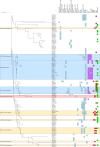Klebsiella pneumoniae clinical isolates with features of both multidrug-resistance and hypervirulence have unexpectedly low virulence
- PMID: 38042959
- PMCID: PMC10693551
- DOI: 10.1038/s41467-023-43802-1
Klebsiella pneumoniae clinical isolates with features of both multidrug-resistance and hypervirulence have unexpectedly low virulence
Abstract
Klebsiella pneumoniae has been classified into two types, classical K. pneumoniae (cKP) and hypervirulent K. pneumoniae (hvKP). cKP isolates are highly diverse and important causes of nosocomial infections; they include globally disseminated antibiotic-resistant clones. hvKP isolates are sensitive to most antibiotics but are highly virulent, causing community-acquired infections in healthy individuals. The virulence phenotype of hvKP is associated with pathogenicity loci responsible for siderophore and hypermucoid capsule production. Recently, convergent strains of K. pneumoniae, which possess features of both cKP and hvKP, have emerged and are cause of much concern. Here, we screen the genomes of 2,608 multidrug-resistant K. pneumoniae isolates from the United States and identify 47 convergent isolates. We perform phenotypic and genomic characterization of 12 representative isolates. These 12 convergent isolates contain a variety of antimicrobial resistance plasmids and virulence plasmids. Most convergent isolates contain aerobactin biosynthesis genes and produce more siderophores than cKP isolates but not more capsule. Unexpectedly, only 1 of the 12 tested convergent isolates has a level of virulence consistent with hvKP isolates in a murine pneumonia model. These findings suggest that additional studies should be performed to clarify whether convergent strains are indeed more virulent than cKP in mouse and human infections.
© 2023. This is a U.S. Government work and not under copyright protection in the US; foreign copyright protection may apply.
Conflict of interest statement
The authors declare no competing interests.
Figures






References
Publication types
MeSH terms
Substances
Associated data
Grants and funding
LinkOut - more resources
Full Text Sources

